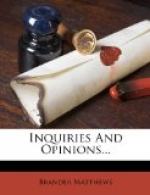These two situations, however, are far less effective in evoking the special pleasure proper to the theater than the nineteenth on M. Polti’s list, “To kill unknowingly one of your own blood.” The full force of the theatric effect of this situation is dependent on the spectators’ complete knowledge of the relationship of slayer and slain, unsuspected by the victims themselves; and the strength of the situation resides not in the mere killing, which may indeed be averted at the last moment, but in the steadily gathering dread which ought to accompany the preparations for the evil deed. This situation in one or another of its subdivisions we find in ‘Nicholas Nickleby,’ as well as in ’OEdipus the King’ and in ‘Lady Inger of Ostraat’; in Sophocles it is a son who murders his unknown father, and in Ibsen it is a mother who murders her unknown son. It is to be found in the ‘Semiramis’ of Voltaire, in the ‘Merope’ of Alfieri, in the ‘Ion’ of Euripides, and again and again in Victor Hugo’s dramas. M. Polti points out that this single situation is utilized as the culminating point at the very end of four of Hugo’s plays—the ‘Burgraves,’ ‘Marie Tudor,’ ‘Lucrece Borgia’ and ’Le Roi s’amuse’ (which supplied the plot for the opera of ‘Rigoletto’) and he insists further that one or another subdivision of this situation has been employed by Hugo at least five times in the single drama of ‘Lucrece Borgia.’ If there are still any who hold that Hugo as a dramatist was “of the race and lineage of Shakspere,” they may find instruction in the fact that this highly artificial situation, which the superb French lyrist was seemingly unable to leave out of his arbitrarily complicated plots, was not employed even once by the great English dramatist.
Probably nothing would have more disagreeably surprized Hugo—who held himself to be extraordinarily prolific and various, and who indeed had abundant reason for this belief—than the disclosure of the fact that he had made use so often of a single situation. And this is evidence, if any was needed, that the repetition of the same situation by the same author, or even by a succession of authors down thru the ages, is more often than not wholly unconscious, and that it is the result, not so much of any poverty of invention, as of the absolute limitation of the number of possible situations. The utmost of novelty that any plot-maker may hope to attain now in the twentieth century is only the result of his own shuffling of the same pack with which all the plot-makers of the past have been playing. A new principle he can scarcely hope to invent for himself; and all that he can safely claim for his most original sequence of scenes is a patent on the combination.




